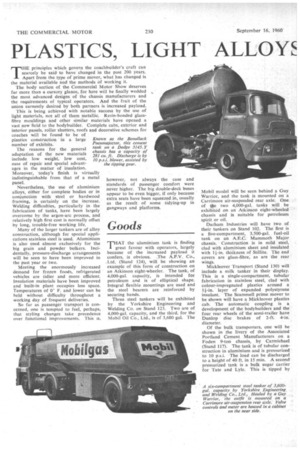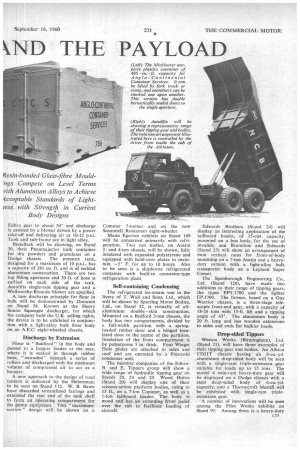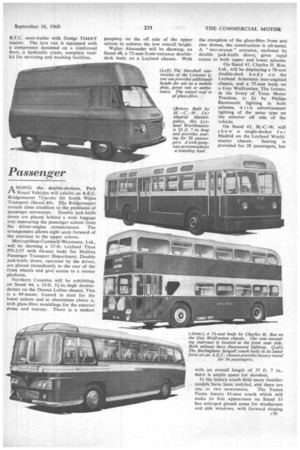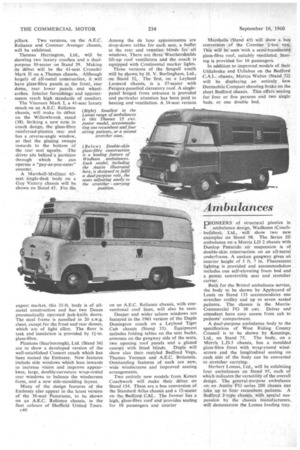PLASTICS, LIGHT ALLOY ND THE PAYLOAD
Page 152

Page 153

Page 154

Page 157

Page 158

If you've noticed an error in this article please click here to report it so we can fix it.
THE principles which govern the coachbuilder's craft can scarcely be said to have changed in the past 200 years. Apart from the type of prime mover, what has changed is the material available and the methods of working it.
The body section of the Commercial Motor Show deserves far more than a cursory glance, for here will be finally wedded the most advanced designs of the chassis manufacturers and the requirements of typical operators. And the fruit of the union earnestly desired by both partners is increased payload.
This is being achieved with notable success by the use of light materials, not all of them metallic. Resin-bonded glassfibre mouldings and other similar materials have opened a vast new field to the bodybuilder. Complete cabs, exterior and interior panels, roller shutters, roofs and decorative schemes for coaches will be found to be of plastics construction in a large number of exhibits.
The reasons for the general adaptation of the new materials include low weight, low cost, ease of repair and special advantages in the matter of insulation. Moreover, today's finish is virtually indistinguishable from that of a metal panel.
Nevertheless, the use of aluminium alloys, either for complete bodies or in conjunction with steel or hardwood framing, is .certainly on the increase. Welding difficulties, particularly in the fabrication of tanks, have been largely overcome by the argon-arc process, and relatively high first cost is normally offset by long, trouble-free working life.
Many of the larger tankers are of alloy construction, although for special applications stainless steel is used. Aluminium is also used. almost exclusively for the big grain and powder bulkers. Incidentally, pressure-discharge arrangements will be seen to have been improved in the past year or two.
Meeting the enormously increased demand for frozen foods, refrigerated vehicles are tidier and more efficient. Insulation materials have been improved and built-in plant occupies less space. Temperatures of 0° F. and lower can be held without difficulty throughout a working day of frequent deliveries.
So far as passenger transport is concerned, one is tempted to feel, perhaps, that styling changes take precedence over functional improvements. This is,
Goods
--rHAT the aluminium tank is finding 1 great favour with operators, largely because of the increased payload it confers, is obvious. The A.P.V. Co., ,Ltd. (Stand 124), will be showing an example of this form of construction on an Atkinson eight-wheeler. The tank, of 4,000-gal. capacity, is intended for petroleum and is of elliptical shape. Integral flexible mountings are used and the steel bearers are reinforced by securing bands.
Three steel tankers will be exhibited by the Yorkshire Engineering and Welding Co. on Stand 123. Two are of 4,000-gal, capacity, and the third, for the Mobil Oil Co., Ltd., is of 3,600 gal. The Mobil model will be seen behind a Guy Warrior, and the tank is mounted on a Carrimore air-suspended rear axle. One of *e two 4,000-gal tanks will be exhibited on an Atkinson eight-wheeled chassis and is suitable for petroleum spirit or oil.
Darham Industries will have two of their tankers on Stand 102. The first is a five-compartment, 3,500-gal. fuel-oil tank on an A.E.C. Mammoth Major chassis. Construction is in mild steel, clad with aluminium sheet and insulated with 14-in. thaness of Stillite. The end covers are glass-fibre, as are the rear wings.
Mickleover Transport (Stand 130) will include a milk tanker in their display. This is a single-compartment, tubular fabrication in stainless steel, clad with colour-impregnated plastics around a 14-in, layer of expanded polystyrene insulant. The Scammell prime mover to be shown will have a Mickleover plastics cab. The automatic coupling is a development of the bodybuilders and the four rear wheels of the semi-trailer have Dunlop disc brakes of 2-ft. 4-in. diameter.
Of the bulk transporters, one will be shown in the livery of the Associated Portland Cement Manufacturers on a Foden 9-ton chassis, by Carmichael (Stand 117). The tank is of tubular construction in aluminium and is pressurized to 10 p.s.i. The load can be discharged to a height of 40 ft. in 15 mm. A second pressurized tank is a bulk sugar carrier for Tate and Lyle. This is tipped by Edbro gear to about 30° and discharge is assisted by a blower driven by a power take-off and delivering air at 10-12 psi. Tank and sub-frame are in light alloy.
Bonallack will be showing, on Stand 30, their Pneumajector bulk container for dry powders and granulates on a Dodge chassis. The pressure tank, designed for a maximum of 10 p.s.i., has a capacity of 281 Cu. ft. and is of welded aluminium construction. There are two top filling apertures and 30 ft. of hose is carried on each side of the tank. Autolifts single-ram tipping gear and a Wellworthy-Ricardo blower are specified.
A new discharge principle for flour in bulk will be demonstrated by Duramin on Stand 54. Known as the Henry Simon Squeegee discharger, for which the company hold the U.K. selling rights, the device is to be exhibited in conjunction with a light-alloy bulk flour body on an A.E.C. eight-wheeled chassis.
Discharge by Extrusion
Flour is " fluidized " in the body and passed to a hopper feeder at the rear, where it is sucked in through rubber hose, "extruded" beneath a series of rollers and discharged with the minimum volume of compressed air to act as a booster.
A new approach to the design of road tankers is indicated by the Helmsman, to be seen on Stand 112. W. B. Bawn have discarded streamlined fairings and extended the rear end of the tank shell to form an operating compartment for the pump equipment. This " maximumsection " design will be shown on a Commer 7-tonner and on the new Scammell Routeman eight-wheeler.
Mann Egerton exhibits on Stand 109 will be concerned primarily with refrigeration. Two van bodies, on Austin 2and 4-ton chassis, will be shown, fully insulated with expanded polystyrene and equipped with hold-over plates to maintain —5° F. for up to 10 hours. Also to be seen is a shipborne refrigerated container with built-in convector-type refrigeration plant.
Self-containing Condensing
The refrigerated ice-cream van in the livery of T. Wall and Sons, Ltd., which will be shown by Spurling Motor Bodies, Ltd., on Stand 22, is virtually of allaluminium double skin construction. Mounted on a Bedford 3-ton chassis, the body has two compartments, divided by a full-width partition with a springloaded rubber door and a hinged insulated door in the centre of the partition. Insulation of the front compartment is by polystyrene 5 in. thick. Four Winget Dole plates are attached to sides and roof and are operated by a Prestcold condenser unit.
The member companies of the EdbroB. and E. Tippers group will show a wide range of hydraulic tipping gear on Stands 20, 24 and 25. Wood Hoists (Stand 20) will display one of their scissors-action platform bodies, rising to 13 ft., on a 7-ton Cornmer, as well as a 1-ton tailboard loader. The body is wood and has an extending front panel over the cab to facilitate loading of aircraft. Edwards Brothers (Stand 24) will display an interesting application of the tailboard loader, of 15-cwt. capacity, mounted on a bus body, for the use of invalids, and Bromilow and Edwards (Stand 25) will show an arrangement of twin vertical rams for front-of-body mounting on a 7-ton Austin and a heavyduty version with a light-alloy bulk transporter body on a Leyland Super Comet.
The Spenborough Engineering Co., Ltd. (Stand 120), have made two additions to their range of tipping gears, the types Erf.1700 and the lighter EP.I700. The former, based on a Guy Warrior chassis, is a three-stage telescopic front-end gear, with a capacity of 18-20 tons with 13-ft. lift and a tipping angle of 43°. The aluminium body is 20 ft. long and has wooden extensions to sides and ends for bulkier loads.
Drop-sided Tippers
Weston Works (Birmingham), Ltd. (Stand 21), will have three examples of their tipping gear and bodies. An Albion CD21T chassis having an 8-cu.-yd. aluminium drop-sided body will be seen with a single-ram triple-extension gear suitable for loads up to 15 tons. The model 4 twin-ram heavy-duty gear will be displayed on a Dodge chassis with a steel drop-sided body of 6-cu.-yd. capacity, and a Thornycroft Mastiff will be exhibited with single-ram triple extension gear. .
A number of innovations will be seen among the Pilot Works exhibits on Stand 97. Among them is a heavy-duty c35 high-speed combined take-off and pump unit with a twin-ram underbody tipping gear on an A.E.C. Mammoth. This is designed to tip 12 tons to 55°. The 14-cu.-yd. body, to the order of Wimpeys, is in light alloy.
Among the many specialized forms of bodywork to be seen at Earls Court, Alfred Miles, Ltd., will be showing, on Stand 101, a well-equipped self-contained fire appliance on a Land-Rover 88-in.wheelbase chassis. The light-alloy body accommodates a crew of four and equipment includes a 150-gal, water tank, Coventry Climax 250-350 g.p.m. pump, two 20n. deliveries and one 4-in, suction eye.
Exhibiting at Earls Court for the first time, Mickleover Transport will show one-piece plastics moulded bodies on Stand 130. The plastics construction employed is based on inner and outer layers of reinforced resin, which may be colour impregnated, bonded to each side of a foamed plastics layer in sandwich c36 form. This type of construction will be demonstrated in a Karrier Bantam 2-3ton boxvan and in two 5-ton containers of 485and 440-cu.-ft. capacity, both of which have corrugated plastics roller shutters.
On Stand 49, Arlington Bodybuilders are to show two pantechnicons on Leyland Comet and Albion Victor chassis respectively. The former has a capacity of 1,740 cu. ft. and the latter of 1,690 Cu. ft. Both bodies are framed and panelled in aluminium and have softwood flooring. Long translucent strips are let into the roof.
In addition to a self-service shop on a Karrier Bantam chassis and a 1,100-cu. ft. light-alloy Luton van on an E.R.F., J. H. Jennings and Son will be showing an interesting cattle container truck on " Stand 23. The container, on a Thames 7-ton chassis, is of composite construction with oak pillars and mahogany panelling.
A composite-construction van body designed to accept 24 pallets, a normal bulk load or refrigerated cargo is to be introduced on Cocker's stand (No. 74). It is 24 ft. 6 in, long, 8 ft. wide and 8 ft. 6 in. high. The floor has steel and light-alloy rollers, with adetachablecentre deck in light alloy. Pallet trays are provided and there is a locking device to prevent movement. The interior is insulated with Polyzote, and dry-ice containers are installed. The body is to be shown on an E.R.F. eight-wheeled chassis.
An export model of interest to be shown by Reall on Stand 73 is a mobile . workshop on an Eagle four-wheeled trailer chassis. Intended for desert use, the vehicle carries a 12-kW. generator, 10-cwt. hoist and a full complement of machineand hand-tools. The sides are divided horizontally, the lower portion giving additional floor space and the upper forming a useful sun-shield.
• Among University Commercials exhibits (Stand 72) will be a tyre-servicing body on a Morris F.G. 2-ton chassis, and an insulated box body with side doors on a B.T.C. semi-trailer with Dodge 3144AY tractor. The tyre van is equipped with a compressor mounted on a reinforced floor, a hydraulic crane, complete toolkit for servicing and washing facilities,
Passenger
A MONO the• double-deckers, Park PI, Royal Vehicles will exhibit an A.E.C. Bridgemaster 72-seater for South Wales Transport (Stand 40). The Bridgemastcr reveals close attention to the problems of passenger movement. Double jack-knife doors are placed behind a wide luggage tray separating the passenger saloon from the driver-engine compartment. The arrangement allows eight seats forward of the staircase in the upper saloon.
Metropolitan-Carnmell-Weymann, Ltd., will be showing a 27-ft. Leyland Titan P0.2/37 with 64-seat body for Halifax Passenger Transport Department. Double jack-knife doors, operated by the driver, are placed immediately to the rear of the front wheels and give access to a roomy platform.
Northern Counties will be exhibiting, on Stand 44, a 12-ft. 5i-in.-high doubledecker on the Dennis Loline chassis. This is a 69-seater, framed in steel for the lower saloon and in aluminium above it, with glass-fibre mouldings for the exterior dome and canopy. There is a sunken gangway on the off side of the upper saloon to achieve the low overall height.
Walter Alexander will he showing, on Stand 48, a 72-seat front-entrance doubledeck body on a Leyland chassis. With the exception of the glass-fibre front and rear domes, the construction is all-metal. A " two-stream " entrance, enclosed by double jack-knife doors, gives rapid access to both upper and lower. saloons, On Stand 41, Charles H. Roe, Ltd., will be displaying a 78-seat double-deck body on the Leyland Atlantean rear-engined chassis, and a 75-seat body on a Guy Wulfrunian. The former, in the livery of Trent Motor Traction, is lit by Philips fluorescent lighting in both saloons, wi t h advertisement lighting of the same type on the exterior off side of the vehicle.
On Stand 43, M.-C.-W. will show a single-decker f o r Madrid on the Leyland Worldmaster chassis. Seating is provided for 28 passengers, but with an overall length of 35 ft. 7 in., there is ample space for standees.
In the luxury coach field many familiar models have been restyled, and there are one or two newcomers. The Yeates Fiesta luxury 41-seat coach which will make its first appearance on Stand 33 has enlarged glazed areas for windscreen and side windows, with forward sloping pillars. Two versions, on the A.E.C.
Reliance and Commer Avenger chassis, will be exhibited.
Thomas Harrington, Ltd., will be showing two luxury coacles and a dualpurpose 30-seater on Stand 39. Making its debut will be the 41-seat Crusader Mark H on a Thames chassis. Although largely of all-metal construction, it will have glass-fibre panels at the front, rear dome, rear lower panels and wheelarches. Interior furnishings and appointments reach high standards of comfort.
The Viscount Mark I, a 41-seat luxury coach on an A.E.C. Reliance chassis, will make its debut on the Willowbrook stand (38). Striking a new note in coach design, the glass-fibre reinforced-plastics rear end has a reverse-angle window, so that the glazing sweeps inwards to the bottom of the rear seat squabs. The driver sits behind a partition through which he can operate a "pay-as-you-enter" counter.
A Marshall-Mulliner 63seat Single-deck body on a Guy Victory chassis will be shown on Stand 45. For the export market, this 35-ft. body is of allmetal construction and has two Deans pneumatically operated jack-knife doors. The steel frame is panelled in 20 s.w,g. sheet, except for the front and rear domes, which are of light alloy. The floor is teak and insulation is provided by 11-in. glass-fibre.
Plaxtons (Scarborough), Ltd. (Stand 34) are to show a developed version of the well-established Consort coach which has been named the Embassy. New features include side windows which lean inwards to increase vision and improve appearknee, large, double-curvature wrap-round rear windows to balance the windscreen form, and a new side-moulding layout.
Many of the design features of the Embassy also appear in the latest version of the 36-seat Panorama, to be shown on an A:E.C. Reliance chassis, in the fleet colours of Sheffield United Tours.
c40 Among the de luxe appointments are drop-down tables for each seat, a buffet at the rear and venetian • blinds for all windows. There are three• Weathershields lift-up roof ventilators and the coach is equipped with Continental marker lights.
Three versions of the Seagull coath will be shown by H. V. Burlingham, Ltd., on Stand 32. The -first, on a Leyland Leopard chassis, is a 37-seater with Perspex-panelled clerestory roof. A singlepanel hinged front entrance is provided and particular attention has been paid to heating and ventilation. A 34-seat version
on an A.E.C. Reliance chassis, with conventional roof lines, will also be seen.
Deeper and wider saloon windows are featured in the 1961 version of the Duple Donington coach on a Leyland Tiger Cub chassis (Stand 35). Equipment includes folding tables on the seat backs, armrests on the gangway side of the seats, two opening roof panels and a glazed canopy with fitted blinds. Duple will show also their restyled Bedford Vega, Thames Yeoman and A.E.C. Britannia. Outstanding features of each are new, wide windscreens and improved seating arrangements.
Two entirely new models from Kenex Coachwork will make their debut on Stand 134. These are a bus conversion of the Standard Atlas chassis and a 12-seater on the Bedford CAL. The former has a high, glass-fibre roof and provides seating for 10 passengers and courier Marshalls (Stand 45) will show a bus conversion of the Commer i-ton van', This will be seen with a semi-translucent. glass-fibre roof, suitably ventilated. Seating is provided for 10 passengers.
In addition to improved models of their Utilabrake and Utilabus on the Bedford C.A.L. chassis, Martin Walter (Stand 52) will be displaying an entirely new Dormobile Compact shooting brake on the short Bedford chassis. This offers seating for four or five persons and two single beds, or one double bed.
Ambulances
pIONEERS of structural plastics in ambulance design, Wadhams (Coachbuilders), Ltd., will show two new examples on Stand 98. The Series III ambulance on a Morris LD 2 chassis with Dunlop Pneuride air suspension is of double-skin construction on an all-metal underfrarne. A sunken gangway gives ati interior height of 5 ft. 7 in. Fluorescent lighting is provided and accommodation includes one self-elevating foam bed and a patent convertible seat and stretcher carrier.
Built for the Bristol ambulance service, the body to be shown by Appleyard of Leeds on Stand 133 accommodates one stretcher trolley and up to seven seated patients. The chassis is the MorrisCommercial FG 30 cwt. Driver and attendant have easy access from cab to patients' compartment.
A dual-purpose ambulance body to the specification of West Riding County Council is to be shown by Kennings, Ltd., on Stand 75. The body, on a Morris L.D.5 chassis, has a moulded glass-fibre front with wrap-round windscreen and the longitudinal seating on each side of the body can be converted to stretcher carrying.
Herbert Lomas, Ltd., will be exhibiting four ambulances on Stand 95, each of which indicates the versatility of the overall design. The general-purpose ambulance on an Austin FO series 200 chassis can take up to four recumbent patients. A Bedford I-type chassis, with special suspension by the chassis manufacturers, will demonstrate the Lomas loading tray.




































































































































































































































